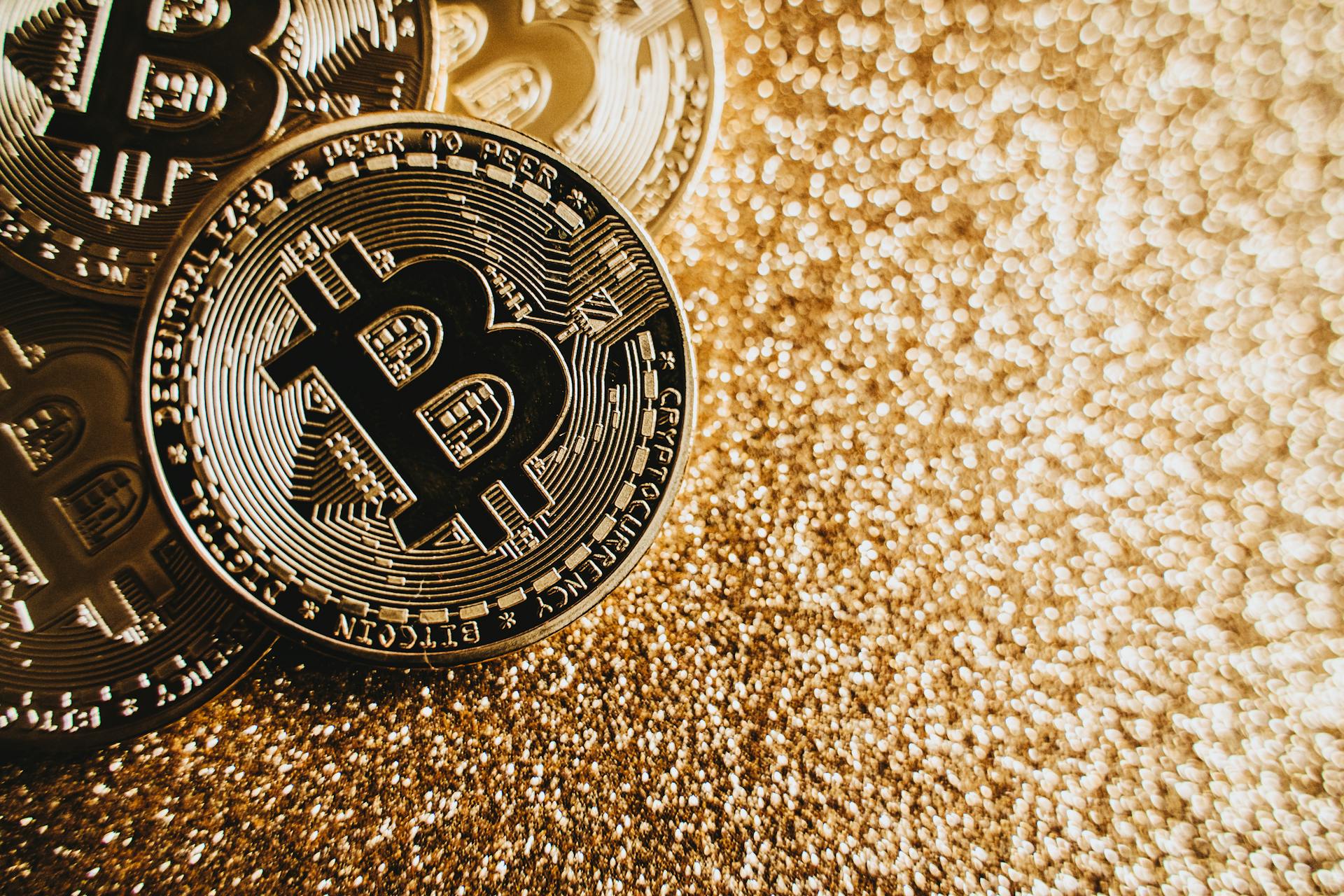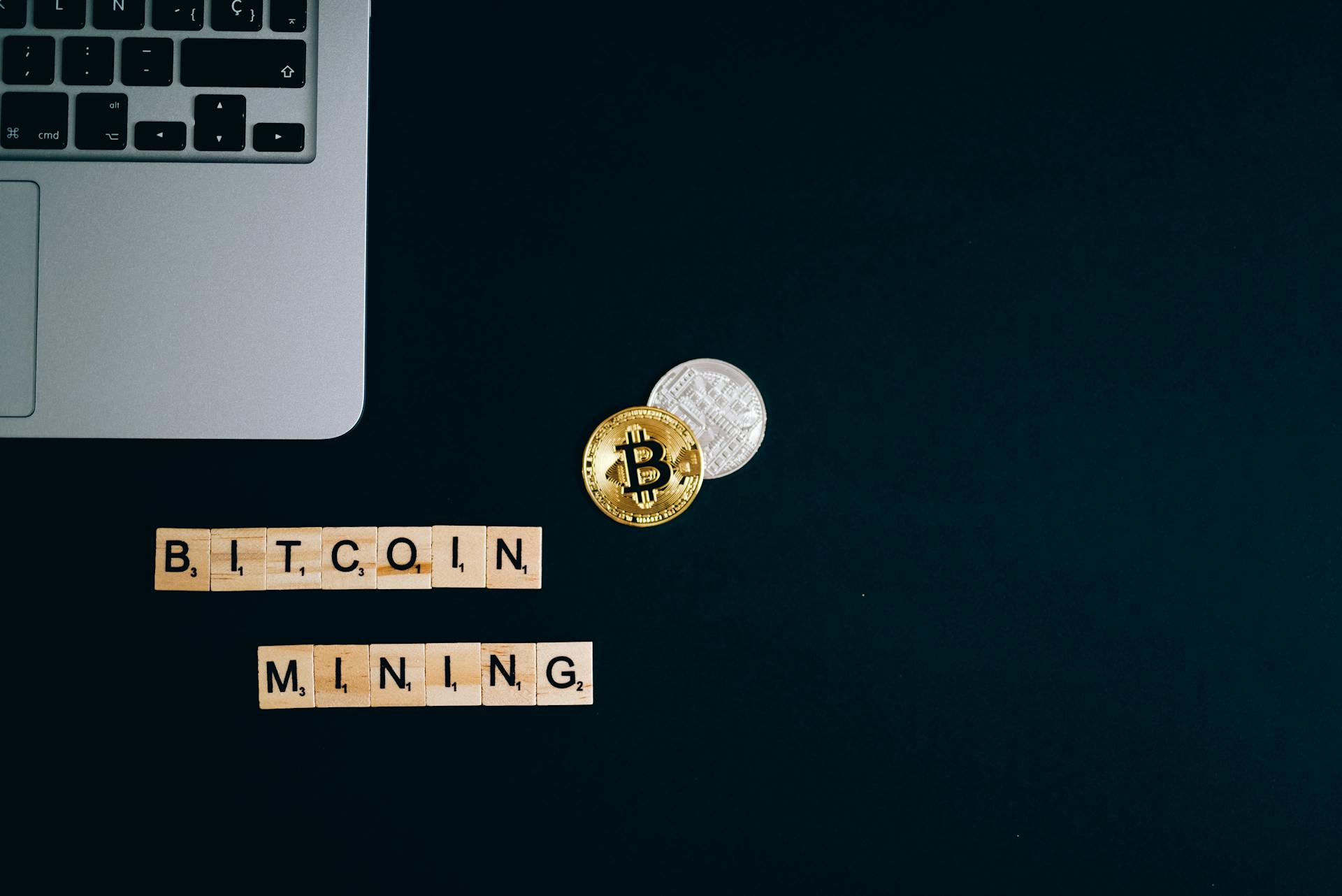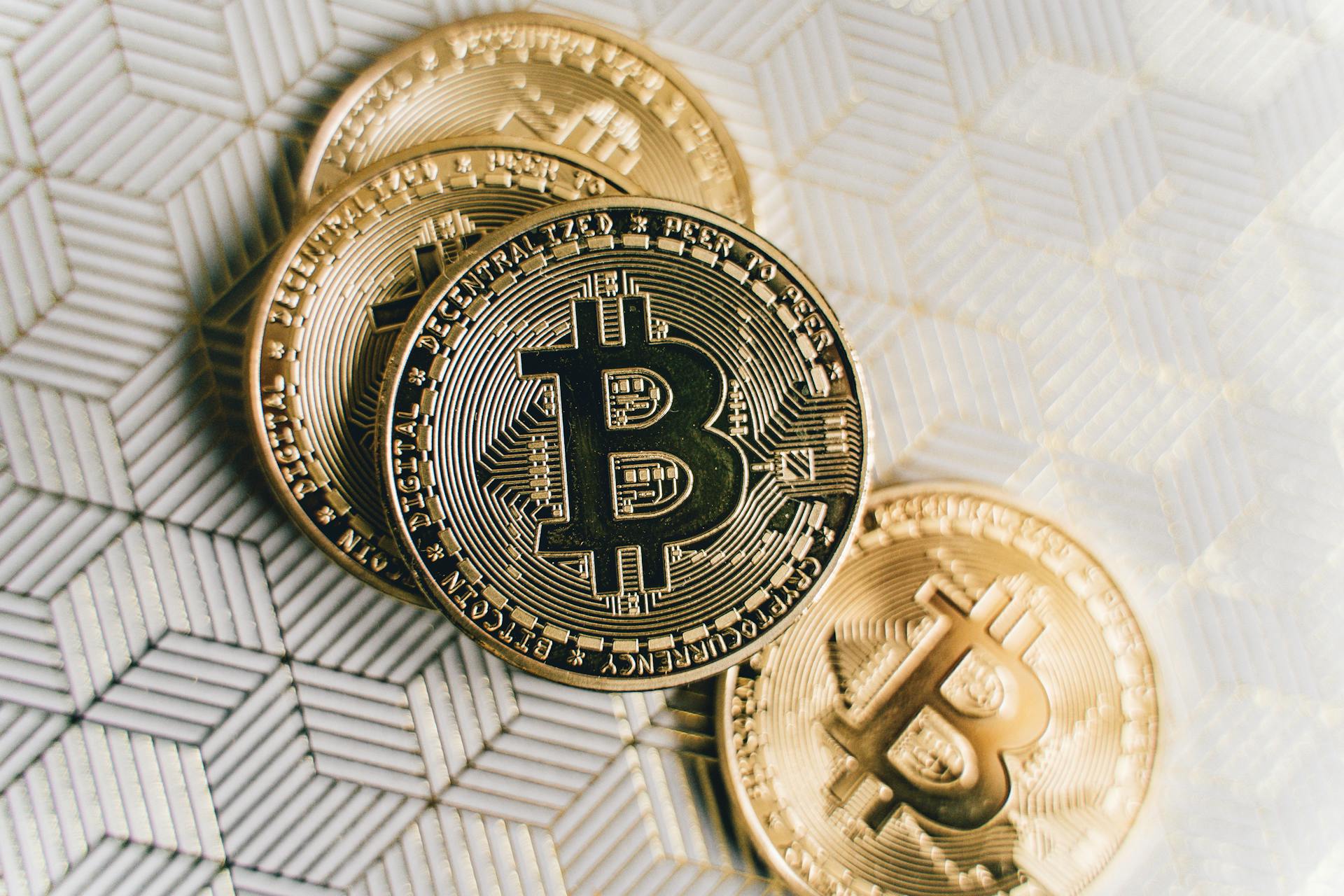
The Bitcoin Network and the Lightning Network are two innovative solutions that have revolutionized the way we think about cryptocurrency transactions.
The Bitcoin Network is a decentralized, open-source, peer-to-peer network that enables the transfer of value without the need for intermediaries.
It's the foundation of the Bitcoin ecosystem, allowing users to send and receive Bitcoins securely and transparently.
The Lightning Network, on the other hand, is a second-layer scaling solution that enables fast and low-cost transactions on top of the Bitcoin Network.
It uses a network of payment channels to facilitate transactions, allowing for near-instant settlement and significantly reducing fees.
This is particularly useful for microtransactions, which are often too small to be processed efficiently on the Bitcoin Network.
Take a look at this: Peer-to-peer Crypto Exchange
What Is Bitcoin?
Bitcoin is a type of digital currency that exists only online. It's decentralized, meaning it's not controlled by any government or financial institution.
Bitcoin is created through a process called mining, which involves solving complex mathematical problems. This process is energy-intensive and requires powerful computers.
Bitcoin transactions are recorded on a public ledger called the blockchain. The blockchain is maintained by a network of computers around the world.
Bitcoin allows for peer-to-peer transactions, meaning you can send and receive money directly with someone else without an intermediary.
If this caught your attention, see: Bitcoin Atm Milwaukee - Coinhub
Scalability and Decentralization Challenges
The Bitcoin network has faced scalability and decentralization challenges since its inception. Nakamoto limited the block size to one megabyte, leading to delayed processing of transactions and increased fees.
This limited block size and frequency have resulted in a bitcoin scalability problem, making it difficult for the network to handle a large number of transactions. Research shows a trend towards centralization in bitcoin as miners join pools for stable income.
A single miner or pool controlling more than 50% of the hashing power would allow them to censor transactions and double-spend coins, posing safety concerns. For example, mining pool Ghash.io reached 51% mining power in 2014, but later voluntarily capped its power at 39.99% for the benefit of the whole network.
Some entities dominate other parts of the ecosystem, such as the client software, online wallets, and simplified payment verification (SPV) clients. This centralization of power can undermine the decentralized nature of the Bitcoin network.
Explore further: Bitmain Technologies Georgia Limited
The Lightning Network
The Lightning Network is a second layer routing network that allows for fast and low-cost transactions. It's secured by penalizing uncooperative participants, which helps prevent fraudulent activities.
To use the Lightning Network, transacting parties first open a payment channel and commit funds to the relevant layer-1 blockchain, such as Bitcoin, under a smart contract. They then make any number of off-chain transactions that update the tentative distribution of the channel's funds.
Cash App implemented the Lightning Network in 2022, making it a widely available option for users.
For another approach, see: Bitcoin Atm Tampa - Coinhub
History
The Bitcoin network has a fascinating history that laid the groundwork for the Lightning Network. The network was created in 2008 by an anonymous individual or group of individuals under the pseudonym Satoshi Nakamoto.
In 2009, the first block of the Bitcoin blockchain, known as the Genesis block, was mined, marking the beginning of the Bitcoin network. This event sparked the development of the network over the years.
Check this out: Bitcoin Block Reward
The Bitcoin network has experienced significant growth and development, attracting the attention of investors, businesses, and individuals worldwide. It remains the most widely known and largest cryptocurrency globally.
One of the key advantages of the Bitcoin network is its decentralized peer-to-peer network with no single point of failure or control. This allows for secure transactions without requiring trust in central authorities.
Here are some of the key events in the history of the Bitcoin network:
- 2008: The Bitcoin network was created by Satoshi Nakamoto.
- 2009: The first block of the Bitcoin blockchain, the Genesis block, was mined.
Second Layer Solution
The Lightning Network is a second layer solution that allows for fast and private transactions on the Bitcoin network. It's like a shortcut that enables users to send and receive funds instantly without having to broadcast every transaction to the entire network.
This is made possible by payment channels, which are off-chain tunnels that allow users to send and receive funds privately. A channel is opened by creating a multi-signature transaction on the Bitcoin blockchain that allocates a certain amount of funds to the channel.
Only the first and last transactions are recorded on the Bitcoin blockchain, and the final balance of the network participants is taken into account. This unique approach makes the Lightning Network a game-changer for Bitcoin transactions.
Transactions on the Lightning Network are nearly instantaneous because they take place off-chain within established payment channels. The cost of such transactions is usually lower compared to payments on the Bitcoin network.
Here's a quick rundown of the benefits of using the Lightning Network:
- Instant transactions: Send and receive funds in real-time.
- Private transactions: Keep your transactions private and secure.
- Low transaction fees: Minimal fees compared to the Bitcoin network.
- No congestion: Avoid block size limitations and congestion on the main Bitcoin blockchain.
In the event that a bi-directional payment channel is no longer open between the transacting parties, the payment must be routed through network intermediaries via an onion routing technique similar to Tor. This requires that the sender and receiver of the payment have open channels with enough established peer nodes to find a path for the payment.
2015-2019
In 2017, an estimated 2.9 to 5.8 million unique users were using a cryptocurrency wallet, with most of them using bitcoin.
The SegWit software upgrade was activated in August 2017, intended to support the Lightning Network and improve scalability.
However, SegWit opponents forked to create Bitcoin Cash, one of many forks of bitcoin, as they supported larger blocks as a scalability solution.
China imposed a complete ban on bitcoin trading in February 2018, causing the price to crash.
The percentage of bitcoin trading in the Chinese renminbi fell from over 90% in September 2017 to less than 1% in June 2018.
Bitcoin prices were negatively affected by several hacks or thefts from cryptocurrency exchanges in 2018.
On a similar theme: When Will Ethereum Etf Start Trading
How It Works
The Lightning Network is a series of side streets that reduce the highway's congestion from smaller transactions on Bitcoin's main blockchain. It's like a shortcut that allows users to make smaller payments without transaction fees or delays.
To use the Lightning Network, two parties set up a multi-signature wallet that holds some amount of bitcoin. This wallet address is then saved to the Bitcoin blockchain, setting up the bidirectional payment channel.
Readers also liked: What Is Bitcoins Blockchain
With the Lightning Network, it's not necessary to set up a direct channel to transact - you can send payments to someone via channels with people you're connected to. The network automatically finds the shortest route.
Each time two parties transact, they sign an updated balance sheet to reflect how much bitcoin is stored in the two wallets. This balance sheet is used to recover their share of the funds in case of a dispute.
The Lightning Network was devised to solve Bitcoin's slow transaction time, throughput, and costs. It's a secondary layer that complements the primary blockchain by adding functionality.
In the event of a dispute, both parties can use the most recently signed balance sheet to recover their share of the funds. This ensures that both parties get their fair share of the bitcoin.
Readers also liked: How Long Do Robinhood Crypto Transfers Take
Benefits and Limitations
The Lightning Network offers several benefits over on-chain transactions, including granularity, allowing for payments smaller than a satoshi. This is particularly useful for microtransactions.
Lightning Network payments also provide privacy, as each node operator can only see payments across their channels, not the source or destination of funds. This is a major advantage over traditional blockchain transactions.
Settlement time for Lightning Network transactions is incredibly fast, occurring in under a minute and sometimes even in milliseconds. This is a significant improvement over the 10-minute confirmation time on the bitcoin blockchain.
The Lightning Network also boasts high transaction throughput, with no fundamental limits to the number of payments per second. This is only limited by the capacity and speed of each node.
Broaden your view: Stablecoin Payments
Benefits
The Lightning Network offers several benefits over traditional on-chain transactions. One of the main advantages is its ability to process payments in a matter of milliseconds, with settlement times under a minute.
This is a significant improvement over the Bitcoin blockchain, which can take up to 10 minutes to confirm transactions. The Lightning Network's speed is due to its off-chain nature, where transactions are processed within established payment channels.
Recommended read: Chain Wallet Crypto

Payments on the Lightning Network can also be made with a high degree of privacy. Each node operator can see payments across their channels, but they won't be able to see the source or destination of those funds if they're non-adjacent.
Another benefit of the Lightning Network is its scalability. There are no fundamental limits to the amount of payments per second that can occur under the protocol. The amount of transactions is only limited by the capacity and speed of each node.
Here are some key benefits of the Lightning Network at a glance:
- Granularity: Payments can be made in amounts smaller than a satoshi.
- Privacy: Node operators can't see the source or destination of funds.
- Speed: Settlement times are under a minute and can occur in milliseconds.
- Scalability: No limits to the amount of payments per second.
Limitations
The Lightning Network has some limitations that are worth mentioning.
The on-chain transactions required to open and close lightning channels limit the scalability of the network.
This can be mitigated if multiple users who trust each other share a lightning node, which can help reduce the number of transactions needed.
A period of 24 hours is allotted to create a bidirectional channel after receiving a request, giving users some time to set up their connections.
The Lightning Network's dispute mechanism requires users to constantly watch the blockchain for fraud, which can be a time-consuming task.
This vigilance can be outsourced to watchtower nodes, trusted providers who are paid to monitor for fraud, making the process more manageable.
Explore further: Cryptocurrency Fraud Lawyer
Security and Risks
The Bitcoin network and Lightning Network have different security and risk profiles.
The Bitcoin network is a decentralized system that requires nodes to validate transactions, which makes it more secure than the Lightning Network.
However, this decentralization also means that each node has to verify every transaction, which can lead to slower transaction times.
The Lightning Network, on the other hand, uses a network of payment channels to facilitate transactions, which makes it faster but also increases the risk of channel hacks.
A single malicious actor could potentially drain an entire channel, but the Lightning Network's design aims to minimize this risk.
The Bitcoin network's decentralized nature also means that it's more resistant to censorship, whereas the Lightning Network's reliance on a network of payment channels makes it more vulnerable to censorship.
A different take: Decentralized Finance Courses
Frequently Asked Questions
What is the difference between Lightning and bitcoin address?
Lightning addresses can be reused multiple times, unlike Bitcoin addresses which are best used once for security and privacy. This added convenience comes without compromising security or privacy
What is the difference between bitcoin Lightning Network and on chain bitcoin?
On-chain Bitcoin transactions are slower and more expensive, but safer for long-term storage, while Lightning Network transactions are fast and cheap, ideal for everyday payments
Featured Images: pexels.com


